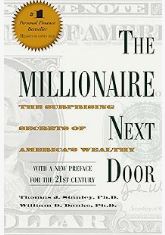 Click on the book to buy on Amazon
Click on the book to buy on Amazon
"The Millionaire Next Door: The Surprising Secrets of America's
Wealthy" by Thomas J. Stanley and William D. Danko is a
groundbreaking exploration of the habits and lifestyles of self-made
millionaires in America. Through extensive research, the authors
reveal that many millionaires live modestly and avoid conspicuous
consumption, challenging common stereotypes about wealth and success.
Here's a detailed summary of the key concepts and chapters:
Introduction: Meet the Millionaires
Stanley and Danko introduce the concept of the millionaire next
door—a person who has accumulated significant wealth through hard
work, frugality, and disciplined saving. They discuss their research
methods and the surprising findings about the lifestyles and habits
of America's millionaires.
Chapter 1: Meet the Millionaire Next Door
The authors present the characteristics of the millionaire next
door, including frugality, discipline, and a focus on long-term
wealth accumulation. They emphasize that many millionaires live
below their means, avoid debt, and prioritize saving and investing
for the future.
Chapter 2: Frugal Frugal Frugal
In this chapter, Stanley and Danko explore the frugal habits of
millionaires and the role of thriftiness in wealth accumulation.
They discuss how millionaires often prioritize value over luxury,
shop for bargains, and avoid unnecessary expenses.
Chapter 3: Time, Energy, and Money
The authors discuss the importance of time management and energy
allocation in achieving financial success. They emphasize that many
millionaires prioritize their time and energy on activities that
generate wealth, such as entrepreneurship and investing.
Chapter 4: You Aren't What You Drive
Stanley and Danko challenge the notion that wealth is reflected
in material possessions, such as cars and homes. They emphasize that
many millionaires drive modest vehicles and live in average
neighborhoods, rather than flaunting their wealth through
conspicuous consumption.
Chapter 5: Economic Outpatient Care
The authors discuss the phenomenon of economic outpatient care,
where affluent parents provide financial support to their adult
children. They explore the impact of such support on the financial
independence and wealth-building habits of the recipients.
Chapter 6: Affirmative Action, Family Style
Stanley and Danko examine the role of family upbringing and
education in shaping the wealth-building habits of individuals. They
discuss the importance of instilling values such as hard work,
self-reliance, and financial literacy from a young age.
Chapter 7: Find Your Niche
The authors discuss the importance of finding a niche or
specialization in one's career or business endeavors. They emphasize
that many millionaires have achieved success by focusing on a
specific industry or market segment and becoming experts in their
field.
Chapter 8: Jobs: Millionaires versus Heirs
Stanley and Danko compare the wealth-building strategies of
self-made millionaires with those of individuals who inherit wealth.
They emphasize that self-made millionaires often prioritize hard
work, entrepreneurship, and prudent financial management, while
heirs may rely more on passive income and inheritance.
Chapter 9: The Market of the Millionaires
The authors explore the market dynamics of affluent consumers and
the industries that cater to their needs and preferences. They
discuss the opportunities for businesses to serve the millionaire
market and the characteristics that distinguish successful companies
in this segment.
Chapter 10: The Foundation Stones
Stanley and Danko conclude the book by summarizing the key
principles of wealth accumulation and success shared by the
millionaires they studied. They emphasize the importance of hard
work, discipline, frugality, and self-reliance in achieving
financial independence and long-term prosperity.